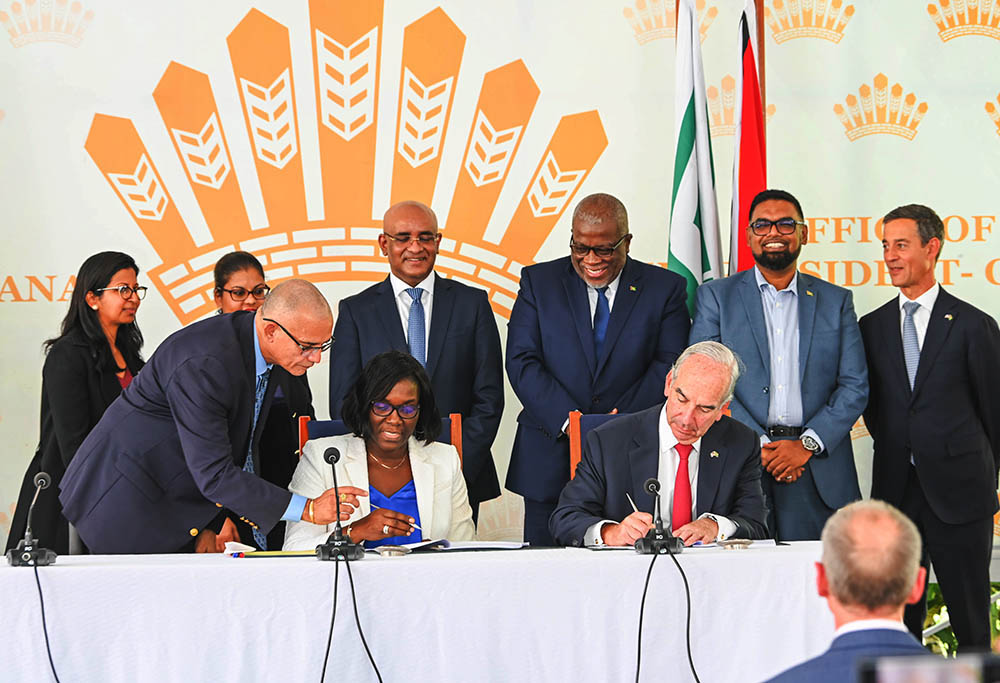The Office of Vice President (VP) Bharrat Jagdeo has defended the process for the awarding of Guyana’s carbon credits and questioned the motives of the Amerindian Peoples Association (APA) in lodging a complaint that could lead to a delay in disbursements.
The APA has complained to the Winrock Architecture for REDD+ Transaction Secretariat (ART), the certifying body for Guyana’s carbon credits programme, alleging the lack of adequate consultations among other defects.
A lengthy rebuttal issued on Saturday by Jagdeo’s office may reflect anxiety that the APA complaint could interrupt what had been hailed as a historic US$750m deal between Guyana and the American oil company, Hess, one of the partners of Exxon in the lucrative offshore Stabroek Block.
The statement by the VP’s office sought to reject some of the APA’s allegations by accusing it of the same things.
It charged the APA with not adhering to the free, prior, and informed consent [FPIC] principle, an accusation noted by the APA in its complaint to ART. The VP’s office statement also questioned the APA’s political neutrality when it referred to its Executive Director, Jean La Rose’s candidacy as Deputy Representative in the APNU + AFC Coalition List and her subsequent appointment to a senior Board position by then President David Granger.
The VP’s office referred to a letter from Toshao Derrick John, Chairman of the National Toshaos’ Council, and published in Saturday’s edition of Stabroek News in which he [John] accused the APA of not informing or consulting with indigenous villages, the National Toshaos Council, or any representative group of the Indigenous Peoples of Guyana in relation to the complaint to the ART Secretariat. According to statement from Jagdeo’s office, it is the APA which violated the FPIC principle.
In outlining the process undertaken in Guyana’s application under ART and the APA’s selective participation, the statement said that as part of the audit of Guyana’s application for 2016-2020, an independent verifier conducted an assessment mission to several Indigenous villages to inform their findings. Further, the verifier engaged with multiple stakeholders in more than 20 sessions. The statement noted that the APA was invited and participated in the independent verifier’s session. Additionally, the APA was also invited at the end of this stakeholder meeting, to follow up with the auditor should this be needed. The APA, according to Jagdeo’s office, made no such request and expressed no request for follow-up or concern to the Auditors in the Audit Process. In fact, for over two years, the VP’s statement says, the APA was invited by the Office of the President to participate in, and to help lead, consultations across Guyana concerning the LCDS 2030 and ART.
The VP’s statement said that the APA was very selective in its engagement in the consultation that it now raises grievances about. The statement cited as an example that the APA was asked to join other stakeholders on the LCDS Communications Sub-Committee but did not attend or participate in any way. The APA neglected – even though they made an initial offer – to come up with suggestions on addressing some challenges during the national consultations process, such as identifying translators fluent in local languages. Yet, included in their complaint to the ART Secretariat, is a claim of lack of translation into the local indigenous languages.
The release said that unlike other members of the Steering Committee who led consultations, and gathered input and feedback, the APA never fulfilled their responsibility. The release posited that the draft 315 page LCDS 2030 report – https://lcds.gov.gy/summary-of-feedback/ contains records evidencing that extensive consultation were conducted on the LCDS 20230 inclusive of names of persons consulted, dates and minutes of discussions, including names of some of the persons now putting forward inaccurate information.
Benefits-sharing
Regarding the benefits-sharing mechanism, which was also cited in the APA’s Complaint, the VP’s statement noted that Guyana’s jurisdictional/national approach to ART TREES was consulted on and led to suggestions that are documented in the July 2022 version of the LCDS; this was reviewed by the National Toshaos’ Council and other key stakeholders. About the APA claims that remarks made in the consultations were not captured in the 315-page report, the release said that the APA – like all members of the Steering Committee – was asked to review the 315-page report before it was finalized and to raise any issues and recommend changes. According to the release, the APA opted to absent themselves from meetings which considered stakeholders’ feedback and that it [the APA] claimed they had the meeting dates confused.
The VP’s statement said that Guyana’s ART engagement was (i) consulted on at the National Toshaos’ Conference in July 2022 and a resolution passed supporting this engagement: (ii) approved by a Multi-Stakeholder Steering Committee overseeing the LCDS: and (iii) tabled and debated in the Parliament of Guyana with a resolution passed in August 2022. The Endorsement, Approval and Resolution each outline the focus of the LCDS 2030, Guyana’s Jurisdictional ART engagement, and the proposed benefits-sharing mechanism which were all part of this process of review and debate. Regarding this report, the statement cited other members of the Steering Committee claiming to have discovered hundreds of copies of the draft LCDS 2030, given to the APA to help with distribution and consultation, still sitting in the APA’s headquarters. The Office of the Vice President, the statement said, is aware that resources were provided to assist with the distribution of the draft LCDS to communities all across the country.
Stating that the Vice President was concerned and disheartened that thousands of citizens across hundreds of indigenous villages and local communities, are unaware that the APA had called for the suspension of the finances to fund the priorities they are formulating for their future, the statement asked of the APA to inform the public why the APA is seeking to prevent the process of village planning in each community? Why should this process to develop villages utilizing revenues from the carbon credits programme be frozen? And why would the APA, in good faith, prevent Indigenous villages and local communities from accessing carbon credits revenue from 2016 that are already in their bank accounts? The release seeks to elicit from the APA what option does it [the APA] offer the 242 villages and communities to meet their most pressing needs, and those they have developed for their own development?







